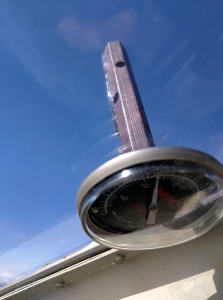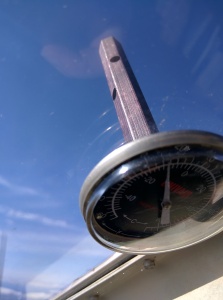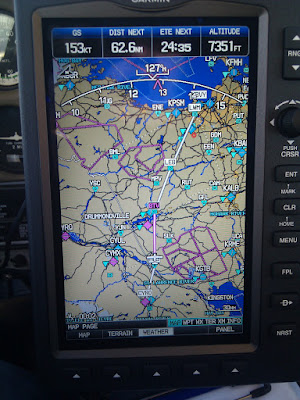Ten years ago today, I passed a flight test and received my Private Pilot’s License (PPL) in a rented Cessna 172 (C-GPMR) at the Ottawa Flying Club.
I’d been worried about turbulence — I didn’t quite have my flying stomach yet, and had nearly thrown up all over the panel during the practice test with my instructor a day or two earlier — but the late-afternoon air that day was still and smooth, and while I didn’t cover myself with glory in every exercise, I did perform them all to the examiner’s satisfaction. After I landed back at Ottawa Airport and started taxiing towards the club, the examiner told me that I’d passed, and was a licensed pilot.
At the time, I knew what my immediate next steps would be: a night rating, then an instrument rating. But after that, what? I had no interest in going on to get my commercial license and instructor rating so that I could teach flying myself on the weekends, and if I just kept renting planes for short local flights, I’d probably get bored in a couple of years (like most new PPLs do). As much as I hate to admit it, the “oh my god I’m in the air!!!” thrill fades after a while, and taking off or landing is about as exciting as parallel parking a car.
As it turns out, I’ve flown a lot over the past 10 years, though I’m still just a bit short of the magic 1,000 hour mark. In December 2002, I bought a used 1979 Piper Warrior and started using it for family trips and business travel (it helped that my consulting customer base suddenly shifted from the California to the US northeast). I flew a lot. I flew in rain, snow, dodged thunderstorms, tried to avoid (and dealt with) icing, and learned how weather changes over long flights. My first big cross-country was four hours to Sault Ste Marie in 2003, before I had my instrument rating, and I got weathered in for a day in North Bay on the way back. Around the same time, I did my first flight down into New York Approach airspace, and didn’t find it frightening at all. Soon, many other trips to big and small airports followed: Montreal, Toronto Island, Halifax, Philadelphia, Gaspé, Washington DC, Boston, Winnipeg, etc. (check out this map of all the airports I’ve flown to). I joined Hope Air as a volunteer pilot, and learned what it’s like to fly on someone else’s schedule and make the kind of complicated go/no-go risk assessments that commercial pilots have to make every day.
I thought I’d upgrade to a faster plane before now, but I’m happy with my Warrior. It’s slow in cruise, and it can barely climb above 7,000 ft on a hot summer day at maximum gross weight (I actually lose altitude in downdrafts), but I’ve been through pretty-much everything with it and know that I can trust it. I know that it will meet the performance numbers in the manual for taking off from a short grass strip with unforgiving trees looming at the end, I know it will let me land safely in a 20+ kt straight crosswind, I know it will keep flying with a bit of ice on the wings and the windshield frosted over, I know it will still let me sort-of control it inside a fast-building TCU, and I know that the heater will keep me from hypothermia when the outside temperature is -38°c. I know that I can get a folded-up wheelchair in through the front door and over the seat when a Hope Air patient shows up with one unannounced (thanks to my flying buddy Mike Hopkinson for help with that one).
Perhaps more importantly, my kids got to grow up seeing Canada and the US from the air as well as from the car window. Halifax is 4 hours away rather than 2 days. The Bay of Fundy looks like a bay. The customs guy in Beverly MA remembers us every year, and likes to chat about the Red Sox with my daughter. We park beside bizjets. At Teterboro Airport near NYC, my daughters used the same lounge as Oprah (though not at the same time).
I don’t fly as much as I used to — more like 70 hours/year vs 120 early on — and if I had a faster, more complex plane, I might have to give it up, because it would cost a lot to own and fly (fuel, insurance, and maintenance costs for my Warrior are a bit less than they would be for a second family car), and I’d have to fly a lot more to stay safe in it. C-FBJO and I are a good fit.
So there we go. I wonder if I’ll still be flying in another 10 years.


 The
The 





 Normally, I mount a Garmin 696 portable GPS on my yoke, with a full-colour moving map, terrain and obstacle alerts, live satellite weather, nearby traffic alerts fed from a Zaon XRX, and even XM satellite radio. For a long cross-country flight, that stuff is very helpful, letting me see and plan for what’s happening 200 miles ahead and listen to the BBC to kill the long hours. It does, however, require a yoke mount and a complex series of power, antenna, and audio wires threaded carefully out of the way around the cockpit.
Normally, I mount a Garmin 696 portable GPS on my yoke, with a full-colour moving map, terrain and obstacle alerts, live satellite weather, nearby traffic alerts fed from a Zaon XRX, and even XM satellite radio. For a long cross-country flight, that stuff is very helpful, letting me see and plan for what’s happening 200 miles ahead and listen to the BBC to kill the long hours. It does, however, require a yoke mount and a complex series of power, antenna, and audio wires threaded carefully out of the way around the cockpit.